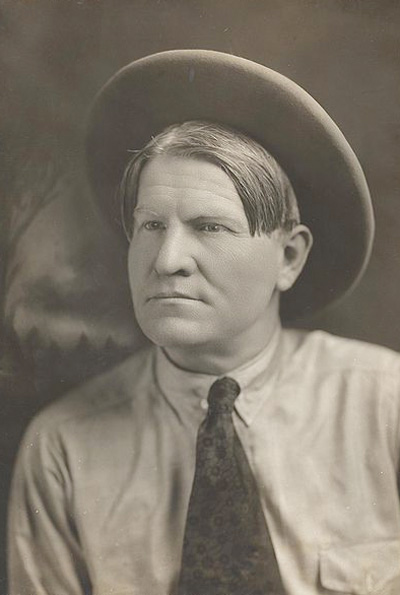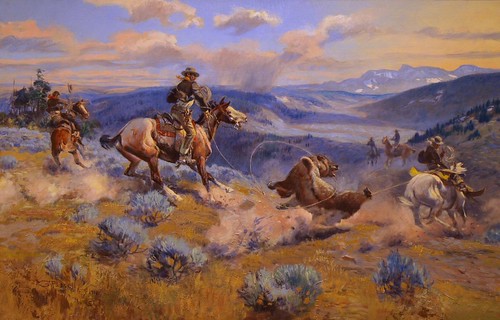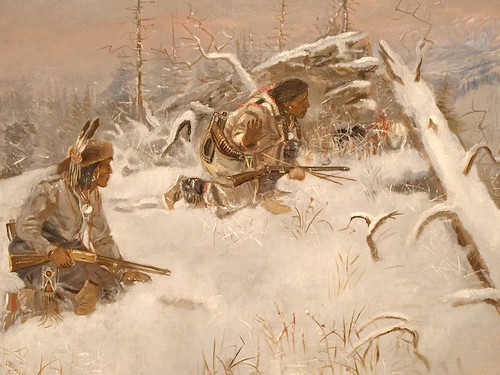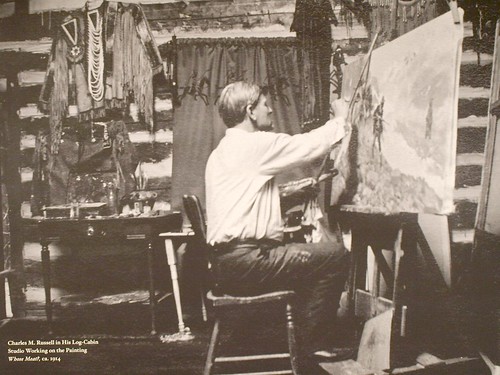

Portrait of CM Russell,1900, Smithsonian Institution
CHARLES M. RUSSELL (1864-1926)
Like Frederic Remington, Charles M. Russell was born to moderate wealth. A native of St. Louis, Missouri, Russell first came to Montana as a boy of 16 with a dream of becoming a real cowboy. He was so captivated with the West he chose to stay and fulfill his childhood fantasy.
Charles M. Russell (1864–1926). From Amon Carter Museum Fort Worth TX
During those first years in Montana, Russell received great encouragement from Jake Hoover, a mountain man who befriended him and took him under his wing. Hoover often shared his cabin with the young Charlie, sometimes providing food and shelter for months at a time. This friendship allowed Russell to experience the ways of the frontier life he would later portray so vividly in his paintings.
1910 Charles M. Russell and Nancy C. Russell on the porch at Bull Head Lodge, Lake McDonald, Montana
In 1882 Charlie landed a job as a wrangler on a cattle drive. He wrangled for eleven years, and while he was not known for being a good roper or rider, Russell established a local reputation as the affable (some said bone lazy) cowboy who loved to draw and knew how to tell a great story. As a self-taught artist, his sketches were crude but reflected an observant eye, a feel for animal and human anatomy, a sense of humor and a flair for portraying action - all hallmarks of Russell's mature art.
Throughout his years on the range, he witnessed the changing of the West. He saw the bitter winter of 1886-87 end the cattleman's dominion on the northern plains. The days of free grass and unfenced range were ending and, for Russell, the cowboy life was over by 1893.
Prior to Russell's marriage to Nancy Cooper, in 1896, only a few of his works had been reproduced nationally. Although he was unsure of his ability to earn a living with his art, Nancy Russell recognized her husband's talent and promise, and provided the business sense and drive that eventually made her unambitious husband one of America's most popular artists. Success did not come easily for the Russells. Montana offered few opportunities for art sales, which eventually led them to New York where contact was established with other artists interested in Western themes. At the very time Frederic Remington was getting out of illustration to concentrate on painting, Russell secured illustrating assignments and began to gain exposure through exhibitions and press coverage. His emergence in the big time art world came in 1911 with a one man show at a New York gallery, followed three years later by an exhibition in London.
 |
1912 Charles M. Russell at the Jake Hoover cabin in Pig Eye Basin, Little Belt Mountains, Montana.
Charles Russell felt deeply the passing of the West, the most evident theme of his art. This sense of loss touched him with an emotional immediacy. He was haunted by youthful fantasies, memories of what once was and by the evidence of change that surrounded him as an everyday reality. His work reflected the public demand for authenticity, but also the soul of a romantic.
Source: Adapted from Brian Dippie, Remington & Russell: The Sid Richardson Collection. Austin: University of Texas Press, 1994. (http://www.sidrichardsonmuseum.org/nu_site/sid_richardson_museum.php/museum/russell)
|
Charles M. Russell arrived in the Montana territory in 1880, at the age of 16. He may have felt he was then in virgin land; but this was not entirely so. The first white men to set foot in the territory were the Verendrye brothers. They were French fur trappers who, in 1742, ventured as far west as the Yellowstone River. It was not until 62 years later that the Lewis and Clark expedition passed through the same territory on the way west and on the way back to St. Louis.
 Through most of the first half of the 1800s, Montana
was inhabited by Indians, including Sioux, Crow, Cheyenne, Assinboine,
Blackfeet, Flathead, Nez Pierce, Pend d'Oreille, Kootenai, and Gros Ventres.
Each tribe had their own homeland and hunting grounds. In the 50 years
following Lewis and Clark, whites were very cautious about entering this
unquestioned Indian domain. A few trappers and fur traders cautiously worked
and tracked on the banks of the Missouri, the Yellowstone, and their
tributaries; but they did so at the mercy of their Indian hosts. They were
simply making a dangerous foray into a harsh but beautiful and bountiful
country.
Through most of the first half of the 1800s, Montana
was inhabited by Indians, including Sioux, Crow, Cheyenne, Assinboine,
Blackfeet, Flathead, Nez Pierce, Pend d'Oreille, Kootenai, and Gros Ventres.
Each tribe had their own homeland and hunting grounds. In the 50 years
following Lewis and Clark, whites were very cautious about entering this
unquestioned Indian domain. A few trappers and fur traders cautiously worked
and tracked on the banks of the Missouri, the Yellowstone, and their
tributaries; but they did so at the mercy of their Indian hosts. They were
simply making a dangerous foray into a harsh but beautiful and bountiful
country.
It was gold that finally turned Montana white. Gold was found there as early as 1850. Thereafter, a series of gold strikes gave rise to boom towns along creeks in the mountainous western portion of the territory. Alder Gulch became Virginia City. Last Chance Gulch later became Helena (the current capitol of Montana). Congress recognized Montana as a territory in 1864, the year of Charlie Russell's birth.
Probably lured by Montana gold, my late husband's grandfather, Caleb Duncan, and his brother George immigrated to Montana from New Brunswick, Canada in the early 1880s. Their names are recorded in the 1880 Montana census of Virginia City. Family accounts indicated they later settled in the Judith Basin area near Lewistown. The poem SHANEY RIDGE is based on an actual incident that marred their lives. At about the same time, Charlie Russell was living with a mountain man named Jake Hoover. He was a trapper, hunter and prospector. Hoover was a man of action and skin hunter who sold meat, among other things, to the ranchers who lived along the Judith River. Hoover by 1880 had built a cabin in the Pig-Eye Basin, where the Judith River leaves the Little Belt Mountains. Russell lived with Hoover for about two years; and when he was not working or exploring the country about him, he was painting. Russell later worked as nighthawk and horse wrangler with a Judith Basin outfit. Caleb Duncan knew Charlie Russell.
(http://charlierussell.org/russellcountry.htm)
 |
Original 1903 log cabin studio of artist Charles Marion Russell, located in Great Falls, Montana, in the United States. The log cabin studio is in its original location, and is currently part of the C. M. Russell Museum Complex.

1915 General view of the cabins and gazebo at Bull Head Lodge, Lake McDonald, Montana
|
 1920 Charles M. Russell, Nancy C. Russell, Josephine Trigg, and an unidentified woman on the porch at Bull Head Lodge, Lake McDonald, Montana.
1920 Charles M. Russell, Nancy C. Russell, Josephine Trigg, and an unidentified woman on the porch at Bull Head Lodge, Lake McDonald, Montana.

1903 Interior view of Charles M. Russell’s newly-completed log cabin studio in Great Falls, Montana.

Charles M. Russell (1864–1926), Loops and Swift Horses are Surer than Lead, 1916.
From The Kimball and Amon Carter Museums Fort Worth TX
 |
| Crow Indians Hunting Elk, 1890 |
http://charlierussell.org/russellcountry.htm
http://www.hamilton1883.com/blog/2010/06/17/meats-not-meat/
http://www.cartermuseum.org/remington-and-russell/timeline?artist=1400&narrative=1523
http://en.wikipedia.org/wiki/File:Charles_M_Russell_Log_Cabin_Studio_-_Great_Falls_Montana_-_September_1976.jpg



 Through most of the first half of the 1800s, Montana
was inhabited by Indians, including Sioux, Crow, Cheyenne, Assinboine,
Blackfeet, Flathead, Nez Pierce, Pend d'Oreille, Kootenai, and Gros Ventres.
Each tribe had their own homeland and hunting grounds. In the 50 years
following Lewis and Clark, whites were very cautious about entering this
unquestioned Indian domain. A few trappers and fur traders cautiously worked
and tracked on the banks of the Missouri, the Yellowstone, and their
tributaries; but they did so at the mercy of their Indian hosts. They were
simply making a dangerous foray into a harsh but beautiful and bountiful
country.
Through most of the first half of the 1800s, Montana
was inhabited by Indians, including Sioux, Crow, Cheyenne, Assinboine,
Blackfeet, Flathead, Nez Pierce, Pend d'Oreille, Kootenai, and Gros Ventres.
Each tribe had their own homeland and hunting grounds. In the 50 years
following Lewis and Clark, whites were very cautious about entering this
unquestioned Indian domain. A few trappers and fur traders cautiously worked
and tracked on the banks of the Missouri, the Yellowstone, and their
tributaries; but they did so at the mercy of their Indian hosts. They were
simply making a dangerous foray into a harsh but beautiful and bountiful
country.









No hay comentarios:
Publicar un comentario